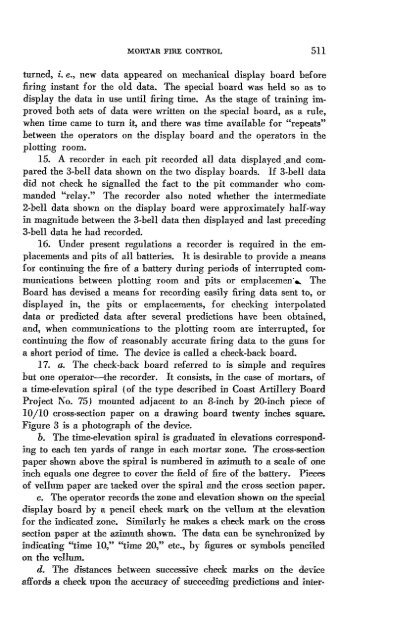COAST ARTILLERY, JOURNAL - Air Defense Artillery
COAST ARTILLERY, JOURNAL - Air Defense Artillery
COAST ARTILLERY, JOURNAL - Air Defense Artillery
Create successful ePaper yourself
Turn your PDF publications into a flip-book with our unique Google optimized e-Paper software.
MORTAR FIRE CONTROL 511<br />
turned, i. e., new data appeared on mechanical display board before<br />
firing instant for the old data. The special board was held so as to<br />
display the data in use until firing time. As the stage of training improved<br />
both sets of data were written on the special board, as a rule,<br />
when time came to turn it, and there was time available for "repeats"<br />
between the operators on the display board and the operators in the<br />
plotting room.<br />
15. A recorder in each pit recorded all data displayed .and compared<br />
the 3-bell data shown on the two display boards. If 3-bell data<br />
did not check he signalled the fact to the pit commander who commanded<br />
"relay." The recorder also noted whether the intermediate<br />
2-bell data shown on the display board were approximately half-way<br />
in magnitude between the 3-bell data then displayed and last preceding<br />
3-bell data he had recorded.<br />
16. Under present regulations a recorder is required in the em.<br />
placements and pits of all batteries. It is desirable to provide a means<br />
for continuing the fire of a battery during periods of interrupted com.<br />
munications between plotting room and pits or emplacemen".. The<br />
Board has devised a means for recording easily firing data sent to, or<br />
displayed in, the pits or emplacements, for checking interpolated<br />
data or predicted data after several predictions have been obtained,<br />
and, when communications to the plotting room are interrupted, fm<br />
continuing the flow of reasonably accurate firing data to the guns for<br />
a short period of time. The device is called a check-back board.<br />
17. a. The check-back board referred to is simple and requires<br />
but one operator-the recorder. It consists, in the case of mortars, of<br />
a time-elevation spiral (of the type described in Coast <strong>Artillery</strong> Board<br />
Project No. 75) mounted adjacent to an 8-inch by 20-inch piece of<br />
10/10 cross-section paper on a drawing board twenty inches square.<br />
Figure 3 is a photograph of the device.<br />
b. The time-elevation spiral is graduated in elevations corresponding<br />
to each ten yards of range in each mortar zone. The cross.section<br />
paper shown above the spiral is numbered in azimuth to a scale of one<br />
inch equals one degree to cover the field of fire of the battery. Pieces<br />
of vellum paper are tacked over the spiral and the cross section paper.<br />
c. The operator records the zone and elevation shoVr'Ilon the special<br />
display board by a pencil check mark on the vellum at the elevation<br />
for the indicated zone. Similarly he makes a check mark on the cross<br />
section paper at the azimuth shoVr'Il.The data can be synchronized by<br />
indicating "time 10," "time 20," etc., by figures or symbols penciled<br />
on the vellum.<br />
d. The distances between successive check marks on the device<br />
affords a check upon the accuracy of succeeding predictions and inter-
















